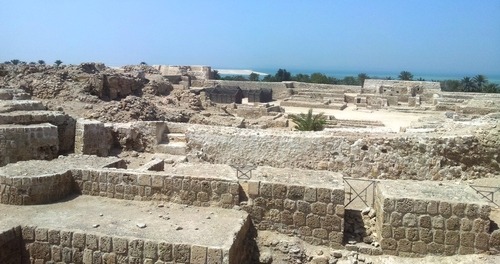
View of the excavated Portuguese fort with the sea behind it, and the palm groves between the two. One of the beautiful sceneries we encountered during our research. Summary
Between 8 and 11 April I visited Bahrain with a group of artists and researchers. The artists had been selected through a call for proposals posted on this website (see here for English and here for Arabic) and communicated through Facebook and e-mail. Liane al Ghusain, Ahmad Makia and Rahel Aima were selected on the basis of their projects (see next post for more information). On the scholarly side I had invited Prof. Mehdi Sabet from Zayed University in Dubai, while my research assistant Amal Bssiss joined us on 10 April. We were kindly hosted by Al Riwaq who provided us with apartments in the hip neighborhood of Adliya and helped us set up meetings.
The objective of this trip was to research Ancient Arabia from the perspective of contemporary cultural issues. Each artist and scholar had his/her own research objectives.
I wish to express my gratitude towards Alexandra Stock, Kanwal Hameed, Zain, Ahmed Buarsali, Saji and the other helpful office staff working under the direction of Bayan Kanoo at Al Riwaq. And also to the FIND team (Mo Ogrodnik, Alaa Edris and others) of New York University Abu Dhabi, that funded this trip as part of my research fellowship. Thanks also to Frances Stafford, Dr. Ali Bushehri and all the other people we met during this trip, who provided us with invaluable information alongside unforgettable hospitality.
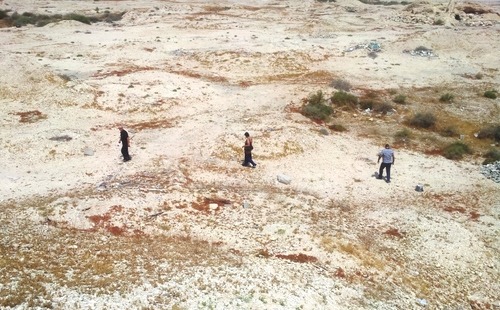
Several team members making their way through the burial mounds of Aali under the scorching sun.
General Impressions
Pre-Islamic Arabia is certainly more present in Bahrain than in other Gulf countries. About 5% of the surface of the island is covered by burial mounds from the Dilmun civilization, 3rd millennia BC to the first centuries BC[1]. Besides the burial mounds, there are quite a few archaeological sites on the island, ranging from temples (Barbar) and forts (Portuguese fort) to whole villages (Saar). Most of these are from the pre-Islamic period. There are also shrines, ancient qanats (underground water channels) and other archaeological vestiges. Bahrain’s museums are full of artifacts found on these sites. Bahrain’s cultural heritage is thus abundant and relatively well preserved – compared to that of neighbouring countries.
Contemporary culture, however, is barely cognizant of this cultural heritage. Bahrain is mainly known in the region for its relatively lax morals; residents of other GCC countries come there to party. Not enjoying the natural wealth of its neighbors – oil supplies in Bahrain have nearly been depleted – Bahrain thrives through trade, tourism and financial services. That requires a certain openness, and that is what the island stands for culturally.
This openness can also be found in the contemporary art sector. It is vibrant and more layered, being several decades older than the art scenes in Kuwait, Saudi Arabia and the Emirates. The Ministry of Culture supports quite a few museums, festivals and artistic institutions, while the private sector also plays an important role in supporting artistic and other creative initiatives.
The relaxed, open and dynamic art scene stands in sharp contrast with the social tensions on the island. The majority of Bahrain’s population is indigenous and quite poor, and the contrasts between rich and poor are growing. The social tensions have a religious dimension, as the indigenous population is mostly Shia while the ruling elites are mostly Sunni. The Al Khalifa royal family is related to the royal families of Saudi Arabia and Kuwait, and has ruled the island since the late 18th century when they arrived from present-day Qatar. Their power has traditionally been buttressed by England, and now by the USA.
As we noticed while driving through the northern half of the island, there are daily clashes between the government and the opposition. The protestors cut off roads and set up blockades with burning tires, to which the government reacts with tear gas, riot police and the cordoning off of entire residential areas. This situation is strangely underreported by the Bahraini and the international media, and it came to us as a surprise. It is likely that only few in the partying crowd of Saudis, Americans from the 8th fleet base in Jufair and Western expats realize that there is daily fighting on the rest of the island.
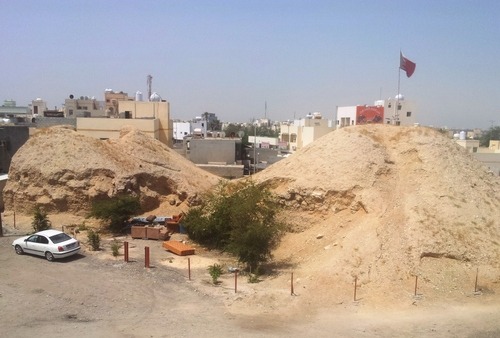
Some of the burial mounds have been integrated into the urban landscape of Aali
Hypotheses about the role of cultural heritage in current political discussions
The discussions I had with different Bahrainis led me to formulate the following hypotheses about the relations between ancient and contemporary culture, as seen through a political prism:
- The discussion of the Island’s Islamic past, in particular the period of the Carmathians (Isma’ili Shia rule, 10th-11th centuries AD, over Bahrain and much of the current Eastern Province of Saudi Arabia) is highly controversial as it implicitly raises questions about the legitimacy of the current rulers, given the current political context. The pre-Islamic past, by contrast, presents less problems.
- This leads to a situation where much of history is rather left blank, unwritten, then written by one of the two sides (Sunni rulers[2] versus Shia indigenous population)[3], as this would certainly exacerbate tensions. No history = good history.
- This in turns leads to disaffection with the whole subject of history and cultural heritage, and to a focus on the surface, on the here and now. Ancient history is acknowledged and appreciated, but not in terms of a relation with present-day Bahrain, as this relation would have to go through the fraught period of Islamic history and the formation of the current national polity. There is thus a severe disconnect between the Island’s present and its past.
- The results of academic and scientific research of the whole history of Bahrain would probably fortify the cultural identity of the local population, which now suffers from being undefined. For example the identification of Bahrain’s Shia with those from Iran is clearly a fallacy. The Arabs of the Northeastern peninsula (encompassing Bahrain, Eastern Saudi Arabia and Bahrain) were Shia before the Persians, and they have little interest in the theories and agitation of post-revolutionary Shia Iran. Even the old Persian community on Bahrain is nationalistic rather than pro-Iranian. But since the cultural identity of the Bahraini indigenous opposition is so unclear, such allegations when made are difficult to dispel.
- As a result of the above, historic research is mainly performed by outsiders, and preferably on the pre-Islamic period. The Bahraini cultural institutions tend to cherry-pick those research results which most interest them (the same can be said of, for example, Western museums, but without conflict these choices are less extreme).
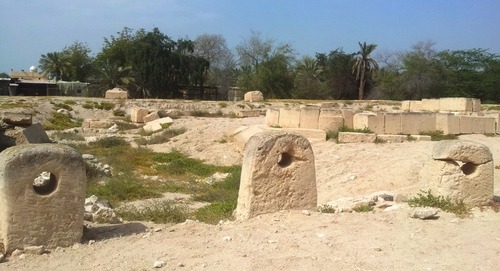
Strange stones at the Barbar temple site
The Carmathians: don’t trust Wikipedia
Specific focus of my research was the Carmathian (or Qarmatian) period. My interest had been sparked by a Wikipedia article which described the Qarmatian regime as being one based on reason, the abolishing of private property, equal rights between all citizens (except the slaves) and vegetarianism. Very little seemed to be known about these people who, from the island of Bahrain (then called Awal) had ruled over the neighboring coasts, and who were known for their ferocious raids on Hajj caravans and their stealing of the black stone from the Ka’aba (they eventually sold it back to the caliph for a ransom).
I shared this information from Wikipedia in my publication ‘The Gulf Art Guide’ and brought it to the attention of many people. It now turns out that this information is incorrect on several key points. As far as historical sources ascertain, the Carmathians were not vegetarian, but were precisely known for their eating of unclean meats such as dog-meat and pork. And the view of their regime, even by their allies (such as the Isma’ili philosopher Nasir Khusraw), seems to have been rather negative: cruelty, despotism, military adventurism. But I still need to consult the original sources, specifically Nasir Khusraw, or find an author who has read them carefully and interpreted them without religious bias.
The mention of the Carmathians mostly drew blank stares from the Bahrainis I spoke to (as if you would mention the Picts to a Briton). The historian Ali Bushehri affirmed that the study of this period was problematic, because it was one of Shia rule; also for the lack of historical evidence about the Carmathians, as they did not practice writing, and few contemporaries wrote about them. In the Bahrain National Museum there is almost nothing about this period. The Carmathians are only mentioned twice, both in the phrase “After the Carmathian period…”.
I speculated whether the contemporary Shia Bahraini identity could be culturally derived from the Carmathian period. Mr. Bushehri didn’t think so, as the Carmathians were Isma’ili, while the roots of Shia Baharni culture went further back in time. There are also still about 600 Isma’ilis living in Bahrain, in a closed community.
It appears I’m on a dead-end track with the Carmathians, but I remain as intrigued by them as before.
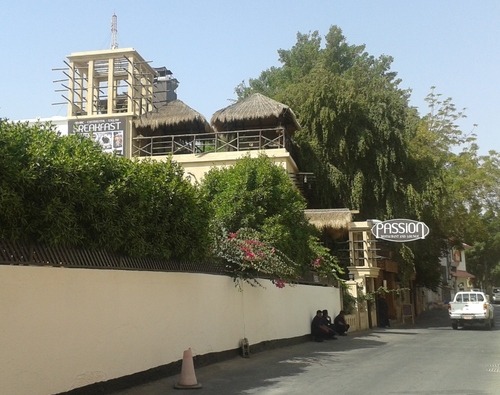
One of the many cool places to hang out, day or night, in Adliya
Bahrain, Love-Paradise
The influx of prostitutes to entertain wealthy visitors in Bahrain may seem dystopic at first sight; considered more carefully, however, this may be in line of a much longer tradition. In the Gilgamesh, the island of Dilmun is already portrayed as a paradise of sorts. The abundance of sweet ground water was explained to us at length by a German hydrologist one evening. Before the ground water was depleted by modern industrial use, it appeared as if there was a sweet-water sea under the salty one: whence the name of the island, ‘two seas’. Sweet water springs in the shallow sea around Bahrain were used, already in antiquity, for different kinds of rites.
Ancient seals depict the centrality of love in ancient Dilmun. While the more obscene ones are hidden from public view, the romantic seals, showing a man and a woman seated opposite each other, drinking a nectar from a shared vessel through straws, have become emblematic for the island. Sea-shells suggesting a woman’s private parts, filled with kohl and other beautifiers, were found next to buried women.
It also seems ancient religions practiced in Bahrain encouraged, at least seasonally, free sexual practices – probably in the guise of fertility rites. This was of course common throughout the Middle East; in the worship of the goddesses of love and of fertility (the Mother-Goddess) temple maids were often required to offer themselves to men. Needless to say, no trace of this erotic past can be found in Bahrain’s museums and public collections of antiquities, while the city’s hotel lounges seem to be full of its contemporary expression.
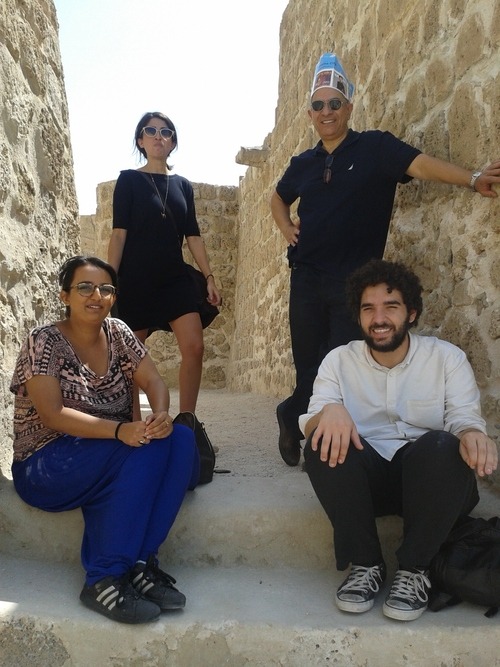 Research team members from left to right: Rahel Aima, Liane al Ghusain, Mehdi Sabet and Ahmad Makia
Research team members from left to right: Rahel Aima, Liane al Ghusain, Mehdi Sabet and Ahmad Makia
Concluding remarks
While my research on Ancient Arabia in Contemporary Culture started out as an investigation of the historical fracture between the great civilizations on the Arabian peninsula before the advent of Islam and its destiny afterwards, I am finding increasingly that other periods of history can be much more problematic. While the UAE lends itself well to my research topic, the minds of artists in Saudi Arabia are much more preoccupied with registering the changes in the country occurred over the last 100 years, while in Bahrain the periods of strong Shia rule are most problematic.
The gaps in the presentations at the National Museum – which, nonetheless, is one of the best of its kind in the region – show how sensitive historic truths can be, and the convenient solution of simply ignoring history, or serving it up as a dish for tourists after a bit of censoring. But this solution ignites the curiosity of artists and researchers like me. Besides those mentioned above, there are many more crevices to explore within Bahrain’s national narrative. I look forward to the results of the artists’ and scholars research trajectories.
This trip seems to have been a very positive and rewarding experience for all involved. Each team member claims to have made substantive progress on his/her research questions, while new interests have emerged. The artists/creative practitioners in our group seemed to be well on their way to making work which could be exhibited at a later date, in any case in a virtual format. This formula is thus one to be repeated.
We will soon put out a call for artistic proposals, for a similar trip to Oman, on this website!
[1] Apparently this proportion used to be close to 10% – it has decreased due to the razing of burial mounds to make place for residences, roads and other infrastructure, but also due to the constant increase of the island’s surface through land reclamation projects.
[2] The ruling elites however include independent historians, intellectuals and creative minds, who would welcome such research – whatever the political implications. On the other hand many common people, both Sunni and quiescent or non-politicized Shia, may not want the situation on the island to be further destabilized by the realities of history.
[3] The division between ‘Sunni rulers’ and ‘Shia indigenous population’ is anything but clear-cut. Not only are there many fractures within each of these blocs, which causes them to align differently according to the issue of contention; there have also traditionally been many other communities living on the island, which also have a say in collective affairs. Nevertheless, for the purpose of the discussion, this simplification is, I believe, legitimate – as long as no simplistic conclusions are drawn as a result.
